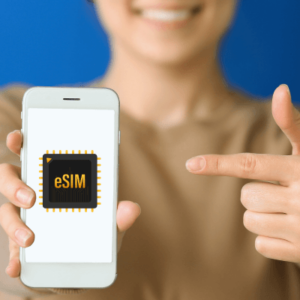Unlike traditional SIM cards, eSIMs are built directly into devices, offering a new level of convenience and flexibility. This article explores the revolution of eSIMs in smart devices, extending far beyond the conventional smartphone to watches, cars, and more.
What is an eSIM?
An eSIM is a digital SIM that activates a cellular plan without a physical card, embedded in devices for a seamless, programmable option allowing easy setup, plan switching, and multiple account management.

The Rise of eSIMS in Smart Devices
Smart devices encompass a wide range of gadgets that connect to the internet and offer interactive features beyond traditional utilities. From wearable tech to smart home devices and vehicles, these smart products offer convenience and enhance our lives with real-time data, remote control, and personalized interactions, seamlessly integrating into our daily routines.
eSIMs in Smart Devices: A Game Changer
The integration of eSIM technology into smart devices is a game-changer, offering several benefits that enhance the user experience. Here’s how:
1. Unprecedented Flexibility
With eSIMs, smart devices can be connected to cellular networks without the hassle of physical SIM cards. This means you can easily switch between carriers or data plans directly from your device’s settings, offering unparalleled flexibility—especially crucial for devices like smartwatches, where space is at a premium.
2. Enhanced Connectivity
eSIMs ensure that more types of devices can remain connected, even without Wi-Fi. From fitness trackers that sync your workout data on the go to cars that receive real-time traffic updates, eSIMs are broadening the scope of what connected devices can do.
3. Global Mobility
For travelers, eSIMs in smart devices mean being able to connect to local networks without the need for physical SIM swaps or costly roaming charges. Whether it’s staying connected on your smartwatch during a run in a foreign city or ensuring your tablet has data for work while abroad, eSIMs make it easier than ever.
4. Sustainability and Space Saving
Eliminating the need for physical SIM cards and trays, eSIMs contribute to making devices slimmer and more sustainable. By reducing the use of plastic and allowing for more efficient use of space within devices, manufacturers can focus on adding more valuable features or enhancing battery life.

The Power of eSIMs in Smart Devices
eSIM technology has quietly been making its way into a variety of smart devices, revolutionizing how we use technology in our daily lives. Here are some examples of eSIM-enabled smart devices and their innovative uses:
Smartphones
Smartphones are the most common type of device to use eSIM technology. With an eSIM, users can easily switch between carriers or data plans without needing to physically replace a SIM card. This is particularly beneficial for travelers who can choose a local data plan while abroad, avoiding roaming charges.
Example: The iPhone 12 and later models support eSIM, allowing users to have dual SIM capabilities—one physical SIM and one eSIM. This feature is perfect for separating personal and business lines or for securing local data plans when traveling.
Smartwatches
Smartwatches with eSIM technology can independently connect to cellular networks, meaning they don’t need to be tethered to a smartphone to make calls, send texts, or use data. This is incredibly convenient for athletes or anyone on the move who doesn’t want to carry around their smartphone.
Example: The Apple Watch Series 6 and later models come with an eSIM feature. Runners can stream music, receive messages, and make emergency calls directly from their watch without needing their iPhones nearby.
Tablets
Tablets with eSIM capability offer the advantage of always-on connectivity for browsing, streaming, and downloading content without relying on Wi-Fi. This is ideal for professionals who need to stay connected on the go or students who want the flexibility to study from anywhere.
Example: The iPad Pro with cellular models offers eSIM support, allowing users to easily switch between data plans worldwide directly from the device settings. This feature is invaluable for those who travel frequently or need a reliable backup internet connection.
Laptops
eSIM-enabled laptops provide seamless connectivity without needing a Wi-Fi network, ensuring professionals and students can work from anywhere. This capability is essential for digital nomads and remote workers who require a constant and secure internet connection.
Example: The Microsoft Surface Pro X is equipped with eSIM technology, enabling users to stay connected with high-speed cellular data. This allows for a more flexible and productive workflow, whether you’re working from a café, airport, or remote location.
Cars
Some modern vehicles come with eSIM technology to enhance the driving experience through features like real-time traffic updates, emergency assistance, and even in-car Wi-Fi hotspots. This ensures that both driver and passengers stay connected and safe on the road.
Example: Tesla’s Model S and X vehicles use eSIMs for connected services like remote diagnostics, software updates, and Autopilot for navigation and cruise control.
The Future of eSIMs in Smart Devices
The potential of eSIM technology in transforming connectivity cannot be understated. We’re already seeing its impact on smartphones and smartwatches. However, its integration into a wider array of devices—including IoT (Internet of Things) gadgets, vehicles, and even utility meters—promises to create a more interconnected and seamless world.
For instance, eSIM-enabled cars can offer enhanced navigation, traffic updates, and emergency services without needing a separate mobile connection. Similarly, household appliances can automatically download software updates, improving functionality and security.
Challenges and Considerations in eSIMS in Smart Devices
Despite the clear benefits, the adoption of eSIMs also presents challenges. Compatibility across devices and carriers, security concerns, and consumer awareness are areas that need addressing. However, as standards evolve and the ecosystem around eSIM technology matures, these challenges are likely to diminish, paving the way for broader adoption.
Conclusion
The integration of eSIMs into smart devices marks a paradigm shift in connectivity. From watches to cars, eSIM technology makes gadgets smarter and more integrated into our digital lives, setting the stage for a new era of enhanced connectivity and convenience.
Your Journey Starts Here in eSIMs in Smart Devices
Ready to explore the world of eSIMs and discover how they can transform your connectivity experience? Click here to start your adventure with the latest eSIM options for all your smart devices. From seamless connectivity to unparalleled flexibility, your next-gen digital life begins with a click. Don’t wait to unlock the full potential of your gadgets. Explore now.



